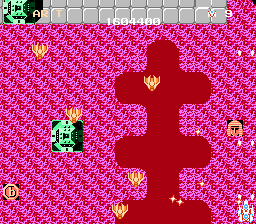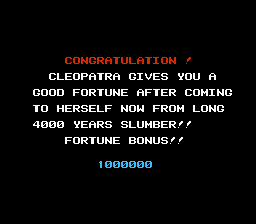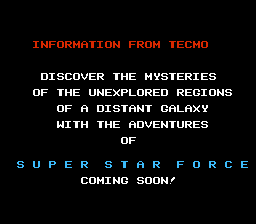Star Force (NES)
| Star Force |
|---|
|
Developers: Hudson Soft (JP),
Tecmo (US)
|
| This article is a work in progress. ...Well, all the articles here are, in a way. But this one moreso, and the article may contain incomplete information and editor's notes. |
| To do: Put in all the music differences and graphical changes. A pretty good comparison video can be found here. |
A port of the 1984 Tehkan coin-op shooter, developed for the Famicom under license by Hudson Soft who would subsequently release Star Soldier as their own self-owned spiritual successor.
Later, Tecmo (no longer Tehkan and now a third-party Nintendo licensee) would release their own port for the NES exclusively overseas. Unbeknownst to unsuspecting international gamers, however... this was not a new port done from scratch, but actually based on Hudson's version!
Contents
Regional Differences
Tecmo extensively modified the game, seemingly to modernize the then-dated graphics and sound. However, some limitations were kept, such as the Greek letters for areas and area targets in the arcade version being replaced with the first letter of the corresponding alphabet (A for ALPHA, B for BETA, G for GAMMA, etc.) instead.
Title Screen
The Japanese version uses a logo closer to the arcade release, while the International versions use a completely new logo, also removing the high score indicator. Compared to the US version, the European version has an animated stellar background rather than a plain black one and it shows the game's HUD. The text font is also slightly different.
| Japan | US | Europe |
|---|---|---|
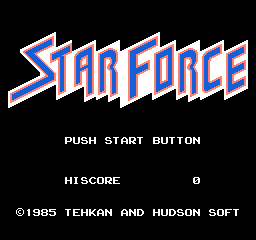
|
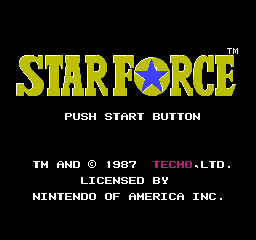
|
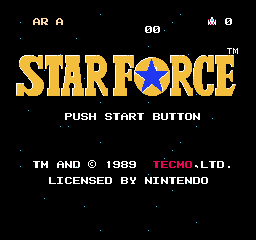
|
Attract Mode
Notably, while the Japanese version features a rolling demo with gameplay after waiting on the title screen for a few seconds, the International versions does not, instead only sitting on the title screen until the player pushes Start to begin the game.
HUD
The International versions move the score one tile to the right. This version also recolors the lives indicator and score.
| Japan | US/Europe |
|---|---|
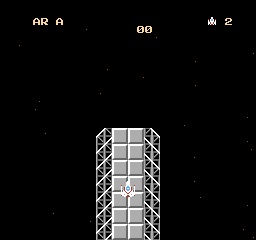 |
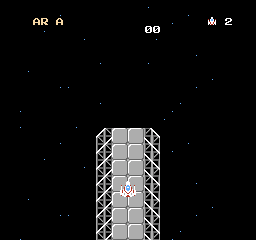 |
Gameplay
| To do: Add more gameplay changes here. More information can be found on the JP Wikipedia page. |
The Famicom port by Hudson Soft was originally planned for a 32KB ROM, but it was downgraded to 16KB, resulting in quite a few features being axed from the arcade version. The International versions, which was developed by Tecmo, features an increased ROM capacity, thus some changes were made to make the port closer to the arcade game.
- Larios takes longer to appear onscreen in the Japanese version after its theme starts playing. The International versions has it quickly appear after its theme starts playing, making it harder to destroy its core before combining.
- Larios movement and bullets speed were made slower in the European version.
Continue?
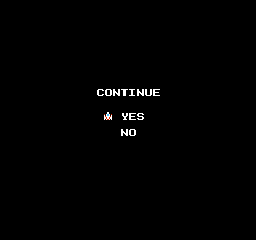
A welcoming addition, only present in the European version, is that you can continue the game, after you lost your last life. In the Japanese and US versions, losing your last life means Game Over and you have to restart the game from scratch. However you can only continue up to three times.
Game Over
| Japan | US/Europe |
|---|---|
 |
 |
The game over tagline was made one line and as mentioned below, the International versions uses a unused track from the arcade original for the game over screen.
Hidden Message
The International versions add a message when you destroy the Cleopatra mask. In Area I (Iota), there is a hidden Cleopatra target which will reveal itself after shooting a certain area on the right side. Shooting that target will show the following message on a separate screen:
This will also net the player a million-point bonus.
This bonus is also present in the arcade release, and is referred to as "The Mystery of the Goddess Continent" 「ゴーデス大陸の謎」 in strategy booklets and other materials from around the arcade game's release.
Ending
After destroying the Omega target in Area O (the last area in the game before going to the Infinity Area), the International versions gives you sort of an ending message that displays an advert for Super Star Force, Tecmo's official sequel to Star Force. However, the game ended up never getting released outside of Japan.
Music
| To do: The files have been added, but there are certainly more comparisons to be made. More additions are welcome! |
The music in the Japanese version was a straight arrangement of the arcade game's original soundtrack, done by unaccredited staff. Though the International versions also lack credits, Keiji Yamagishi has confirmed that he arranged the music and sound effects for the International versions, it being his first task for the company.
While the International versions play more closely to the arcade, music-wise this was reversed, with the Japanese version more closely adhering to the original arcade soundtrack while the international version version takes some creative liberties.
| Title | Japanese | International |
|---|---|---|
| Start | ||
| Main BGM | ||
| Purser (Power-Up) | ||
| Larios | ||
| Area Target | ||
| Clear | ||
| Extend |
- The most notable difference is the international version adding percussion (if somewhat basic) from the noise channel to its soundtrack, while the Japanese version does not use the noise channel at all in its soundtrack and exclusively reserves it for sound effects.
- The following tracks have added noise channel percussion: Main BGM, Purser, Target, and Clear.
- Start/Main BGM: Data-wise, the Japanese version keeps these two as separate tracks, while the International versions attaches the "Start" jingle to the beginning of the "Main BGM" theme and also has a second version without the intro. The International versions has been split into two files here for comparison purposes.
- Start: the International versions plays the second channel at a much higher pitch than the Japanese version.
- Main BGM: the Japanese version features only bass (from the triangle channel) and a constant sustained note playing in the background much like the AC version, but the International versions foregoes this in favor of playing one pulse channel in a staccato fashion, while weaving the secondary melody on the other pulse channel in-and-out along with creative use of pitch bends.
- Larios: This track is extended by 4 bars in the first section and third section before it loops in the International versions, bringing it more in line to the arcade original. Additionally, the Japanese version only uses the triangle channel, while the international version also uses the two pulse channels alongside it.
- Extend: the International versions play its jingle at a much higher key compared to the Japanese version.
Along with rearrangements, Yamagishi also added a few tunes from the arcade game that were left out of the Japanese version, even going so far as to use one track that was originally unused!
| Title | International |
|---|---|
| Bonus | |
| Cleopatra (Congratulation) | |
| Game Over |
- Bonus: This plays in the international version after the player defeats the Larios enemy onscreen before it fully forms, earning 50,000 bonus points in return. This jingle is absent from the Japanese version.
- Cleopatra: This theme plays after destroying the Cleopatra target and after Area Omega is done.
- Game Over: While both the arcade and the Japanese version lack a Game Over theme, the International versions use an unused track from the arcade version for it.
On the other hand, the Japanese version plays a jingle after destroying the Area Target, while this is absent in the International versions which instead immediately move into playing the Area Clear theme.
| Title | Japanese |
|---|---|
| Area Target Destroyed |
Sound Effects
| This page or section needs more audio. There's a whole lotta words here, but not enough audio. Please fix this. Specifically: Please add the sound effects from both the Japanese and International versions. The NSFs with SFX can be found here (courtesy MrNorbert1994). |
Much like the music, the sound effects were also reworked in the international version as well.
- Pages missing developer references
- Games developed by Hudson Soft
- Games developed by Tecmo
- Pages missing publisher references
- Games published by Hudson Soft
- Games published by Tecmo
- NES games
- Pages missing date references
- Games released in 1985
- Games released in June
- Games released on June 20
- Games with regional differences
- Works In Progress
- To do
- Needs more audio
Cleanup > Needs more audio
Cleanup > Pages missing date references
Cleanup > Pages missing developer references
Cleanup > Pages missing publisher references
Cleanup > To do
Cleanup > Works In Progress
Games > Games by content > Games with regional differences
Games > Games by developer > Games developed by Koei Tecmo > Games developed by Tecmo
Games > Games by developer > Games developed by Konami > Games developed by Hudson Soft
Games > Games by platform
Games > Games by publisher > Games published by Koei Tecmo > Games published by Tecmo
Games > Games by publisher > Games published by Konami > Games published by Hudson Soft
Games > Games by release date > Games released in 1985
Games > Games by release date > Games released in June
Games > Games by release date > Games released in June > Games released on June 20
The Cutting Room Floor > Unimportant Awards > NES games
